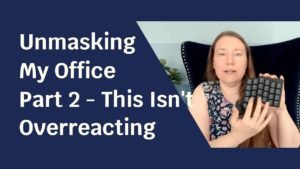The conundrum
At some point in your later identification autism journey, you’ve probably gotten the advice to start to pay attention to your internal experience. You might have even gotten this from me on a few occasions. 😉
But if your internal experience, for any number of reasons, is complicated, or triggering, or numbed out, or it’s really hard, or scary to think about doing that, or if all the times that you’ve tried to, it’s because you’re having a headache or chronic pain or GI troubles, or it’s all about diagnosing something that’s wrong, then you might have lots of associations with it that are negative or painful.
The thing is, that things like knowing what you want or need, what help to ask for, how to make sensory overwhelm better, how to get energy back, even things like what boundaries to set, what accommodations to ask for at work, and how to improve relationships with other people, are all easier to figure out when you have real time feedback from your body about what it’s experiencing, so that you can modify your environment, actions, and interactions based upon that information.
things like knowing what you want or need, what help to ask for, how to make sensory overwhelm better, how to get energy back, even things like what boundaries to set, what accommodations to ask for at work, and how to improve relationships with other people, are all easier to figure out when you have real time feedback from your body
But when getting that information from your body is hard, painful, triggering, complicated, or it’s just not happening, here’s my two cents on how to start.
Before I get into that, though, I’m not going to try and convince you to work on this stuff.
But if you are interested in it, if you’re wanting to do that, in ways that are more gentle, that are not associated with those negative experiences, what I would suggest is looking at neutral experiences at non-relevant times.
Here’s what I mean by that.
First of all, neutral experiences.
This is not about diagnosing your pain. It’s not about trying to figure out if you’re in a meltdown or heading towards one. And it’s not about how to make something better that is not good currently.
Neutral things are like, what sensations are your hands feeling? Are they warm? Cool? Are they wet or dry? What position is your leg in? Is your left ear dry? What sensations do you notice in your right ankle?
Can you notice these sensations without judgement about whether it’s good or bad? Without the need to do anything about it? This is only about noticing.
Is your left elbow warm at the moment? Touch an object; is it scratchy or soft? Or squishy? Or hard? Is it smooth, fuzzy, rough? Noticing those kinds of textures, the quality of sensations, without any relation to making things better or worse. They’re neutral at the moment.
The second part is doing this at non-relevant times.
This is not about trying to fix something, diagnose something in the moment. You might be sitting around, scrolling through YouTube, and there’s nothing that you need to do about it, and think, is my leg comfortable? Is it uncomfortable in some way? Or right now, can you feel the sensations of your hair in the top of your head?
Answering these kinds of deceptively basic questions, that seem like they’re not relevant to anything will, over time, when you to ask more of them, in neutral circumstances at non relevant times, do two things.
It starts to give your nervous system feedback that some bodily experiences can be neutral; they don’t have to all be bad. And that you’re able to experience them.
The other thing that it does is to start to attach meaning to the information from these experiences.
They might seem too minor to make a difference, but they build up in your nervous system.
Here’s another. What is the feel of a piece of paper? Do you have a piece of paper near you now? If you touch it, notice the texture of it, the sound of it, the thickness of the paper. Or when you’re washing your hands, notice what parts of your hand feel wet and what parts are dry, what parts are cold, and what parts are warm.
Noticing those types of things, at times that are not associated with pain or discomfort or troubleshooting or doctors or any medical stuff or gender dysphoria or gender at all, or any negatives — entirely neutral things at non-relevant times, starts to build up a set of experiences that teach your nervous system in very, very slow, gentle ways that it’s okay to experience your own body.
And you’ll start to get feedback from your body at other times, even when you’re not trying to check in with it. And mostly that will be useful types of information. Not 100%, and it might be confusing and it might occasionally be uncomfortable. I’ll be totally upfront with that. It’s going to happen sometimes. But there are other resources on how to deal with that when that happens. I have some, and there are a lot of other good stuff out there, especially from a trauma lens.
Help wanted
By the way, I didn’t set out to make this into a sales pitch, but I can see the logical next question being something like, what questions do I ask?, and I would be remiss if I didn’t mention that there is something to help with that.
I’ve put together an email series called Sensory Moments that is a set of prompts for neutral questions emailed daily at non-relevant times.
You can also do this entirely on your own. It’s not rocket science (I’ve done that; this is a lot easier /gen /lh).
Okay, so to recap, increasing useful internal awareness gently and gradually is most effective and least triggering when it is noticing neutral experiences at non-relevant times.




